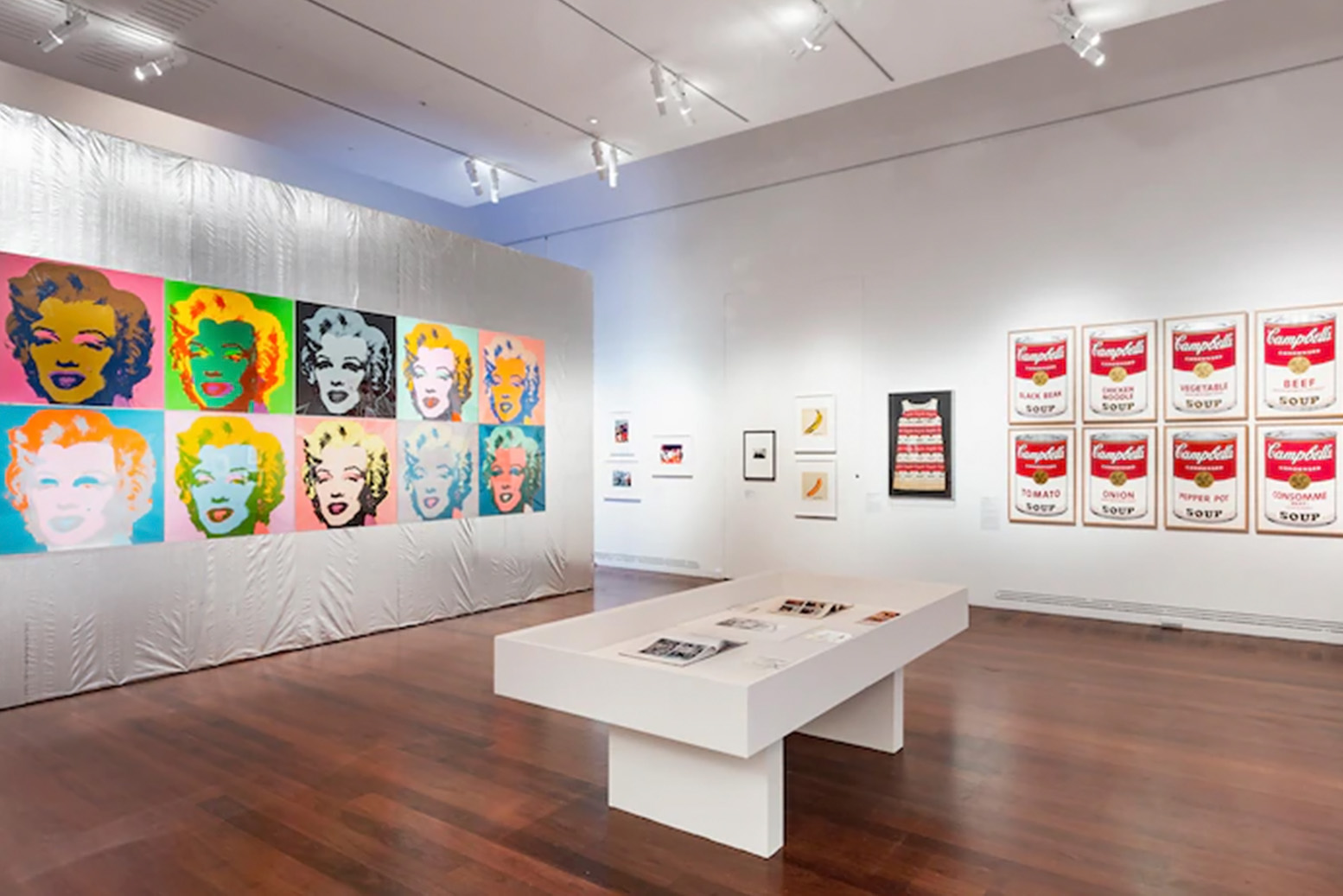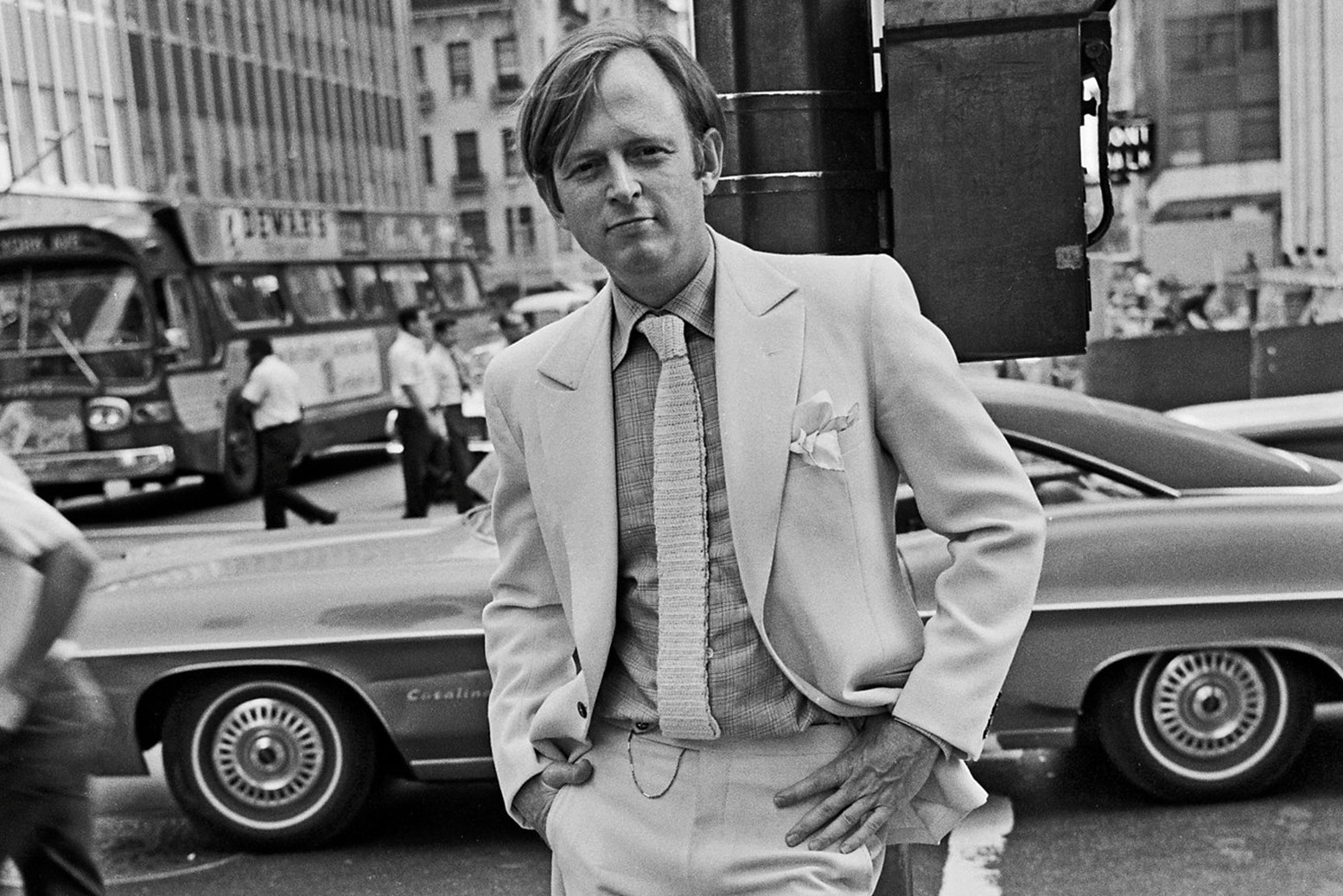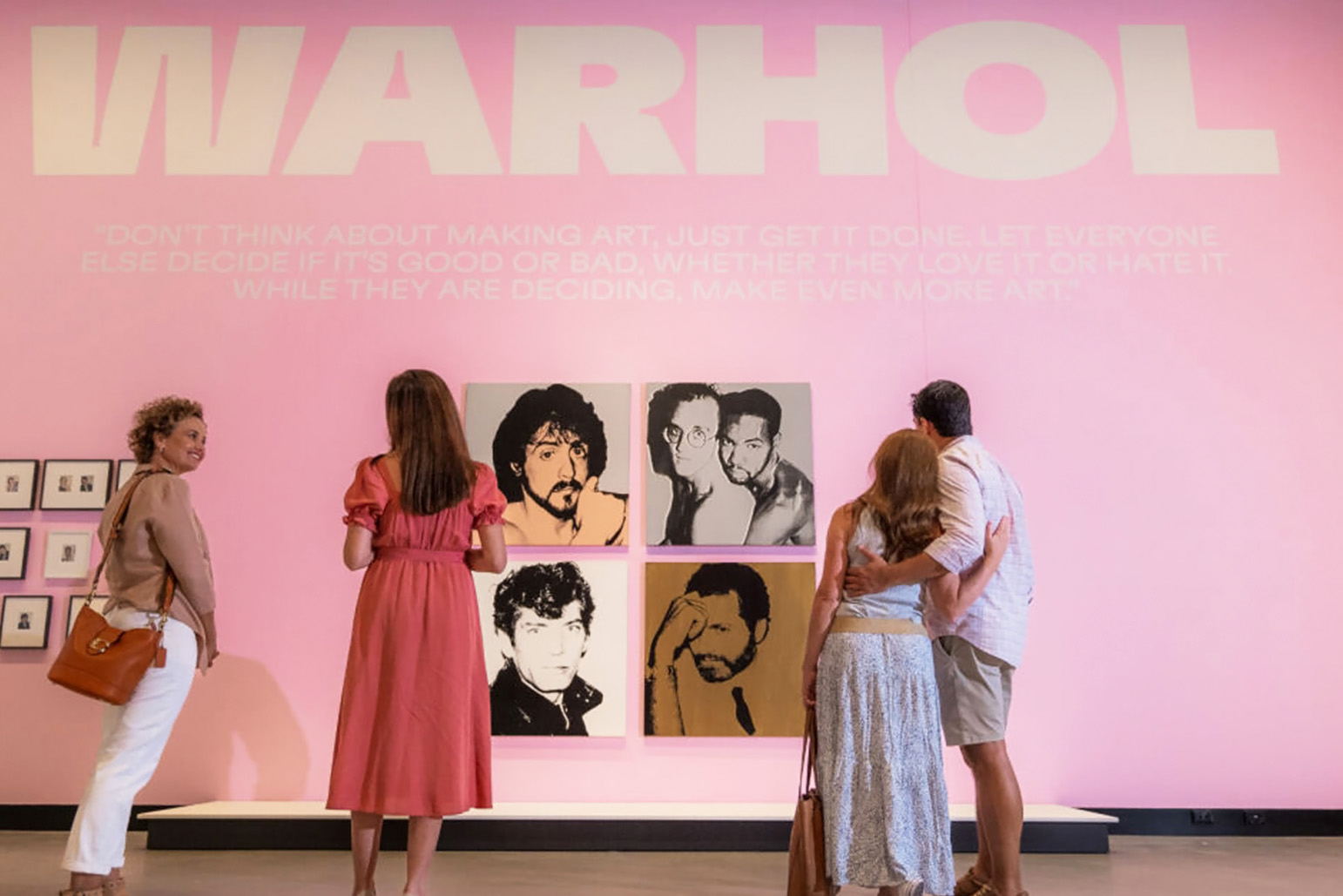


Both the Home of the Arts (HOTA) in Brisbane and the Art Gallery of South Australia (AGSA) have two major Pop art spectaculars currently on show: HOTA is hosting the blockbuster Pop Masters: Art from the Mugrabi Collection, New York while AGSA asks “was Warhol the original influencer?” with Andy Warhol and Photography: A social media. In a recent review of HOTA’s Pop Masters exhibition Chari Larsson, a senior lecturer of art history at Griffith University remarked: “The curatorial argument is clear: Pop art is utterly contemporary.” In a moment of serendipity, a dear friend leant me a yellowed, second-hand copy of Tom Wolfe’s The Painted Word, exclaiming “you simply must read this!” Being familiar with Wolfe’s early counterculture titles like The Kandy-Kolored Tangerine-Flake Streamline Baby and The Electric Kool-Aid Acid Test, my curiosity was piqued.
The Painted Word is a slim volume filled with astute and biting caricatures of the social mechanisms of the art world, including many of the characters related to the HOTA and AGSA blockbusters. Our gonzo journo dives into the New York art scene—the critics, dealers, collectors and curators, and the struggling artists—and surfaces with a book that, upon its publication in 1975, caused a furore among artists and critics alike. It was damned for its simplifications and generalisations, and labelled ludicrous, inaccurate, conservative, and anti-art. Yet, nearly fifty years on, the most caustic moments in the book now appear as fascinating polemics worthy of consideration.
The 100-odd page romp sees Wolfe examine the unusual “rituals” of the art world: the “mating dances” between artists and curators, the mystical exchange of cultural capital between dealers and collectors, and the social hierarchies involved in it all—an eternal game of snakes and ladders. The book is a mishmash of reportage and op-ed, a polemic that unfolds at a blistering pace. The first chapter whizzes through Wolfe’s realisation that art had become “literary”: wall labels explained what he saw, critics educated viewers about meaning, and a more ideological art theory (as opposed to aesthetics) had taken root. “Not seeing is believing, but believing is seeing!” For Wolfe, art began to illustrate the theory, rather than be theorised about. Wolfe recounts that art was not always guided by theory to the extent he now observed, noting many artists’ rejection of the "literary” during the early 20th century (along with Beaux-arts academicism). Because of the subsequent supremacy of theory, art theorists and critics reached new stature in the art world hierarchy—they were able to turn objects into art! Now able to distribute social capital they otherwise could not, the critic ascended, and the artists followed. Theory was the new religion, and art critics were its prophets.
It is important to keep in mind the particular theory Wolfe is referring to, such as Greenberg’s quest for “flatness” and Rosenberg’s heroising of the “Action Painter.” The other key ingredients of this art theory stew include money, celebrity, and fashion. It is a bold thesis, and anyone who tires of long wall labels with complex and/or instructive commentary will likely agree with it. While these observations are more complicated than Wolfe lets on, that is precisely what makes his rhetoric so exciting: his nonchalance, sly wit, keen observation, and the blundering bravado with which he nails his thesis to the front of the book. Wolfe takes a side and leaves it to us, the reader, to judge his argument. From here, Wolfe departs for the loft studios and modern art galleries of New York to examine the “art mating rituals” that take place between artists and curators. The combination of the artists’ craving for success with the ambiguous “meaning” of their work contributes to the critics’ dominance. Wolfe argues that it is in this situation that the authority of the critic is secured.
Perhaps this ‘cult of ego’ phenomena is not new, where critics guide creative endeavour, rather than respond to it. Regardless of broader histories, The Painted Word is a lesson in such cults par excellence. The book is not dissimilar to Wolfe’s other gonzo journalism. Be the subject drugs, sex, religion, revolutionary militia, Wolfe is intrigued by the social relationships involved. In hindsight, the scandalised reviews of The Painted Word appear as overreactions—yet they can offer a window into the Pop art scene of the ‘70s, as much as the book itself. Many, such as Rosalind Krauss, criticised the “caricatures” and “caustic tone” of Wolfe’s text. Yet these are some of the most thrilling parts of the book: concise, unabashed, and opinionated. Wolfe’s remarks during interviews for the book are telling about how he intended it to be taken, as Krauss recounts:
"I don't care, frankly," was Wolfe's consistent reply. "I don't care if the situation never changes. Because if it changes, it might not be as funny. I've had a good time writing about it."
Krauss summed up The Painted Word as "kind of a goof". However (and perhaps due to its softening over time) I did not read it as a goof, but as a provocation or masterful windup. After closing the covers, the quips lingered in my mind. It is a flurried affair, which inevitably is the breeding ground for factual errors here and there. Yet, to pick apart its arguments as if it were a textbook is to miss the point. Like a crafty political cartoon, The Painted Word prods at its subject matter, but also winks at broader truths about “the art scene”.
Back to AGSA and HOTA. If Pop art is “utterly contemporary” then so too is examining the mechanisms that made it some of the most (over)valued art on the market. Wolfe identifies some of these troublesome mechanisms through his examination of the social side of art and its overlap with fashion and cultural capital. We have inherited the results. Looking back at criticism from the heyday of Pop art is a fruitful place to learn how the Pop juggernaut began and how it was received. Hype, celebrity, ego, intensity, and sheer over-the-top-ness are the hallmarks of Pop. Polemical texts like The Painted Word are a means for cutting through the schtick, even if simply to see the work anew. Wolfe sticks a firecracker in the mind of the reader and sets it alight. I found myself laughing, cringing, questioning, disagreeing, conceding, and elating over the course of a single page. The book is a brilliant reminder of the entangled nature of art and ego, and an excellent aid for navigating blockbuster exhibitions like those at AGSA and HOTA.
In the end, the lesson is clear: take the work seriously, not yourself.
Image credits:
1. HOTA, Pop Masters: Art from the Mugrabi Collection, New York.
2. Tom Wolfe in Manhattan, 1968.Credit: Sam Falk/The New York Times.
3. AGSA/Saul Steed.
The Painted Word is a slim volume filled with astute and biting caricatures of the social mechanisms of the art world, including many of the characters related to the HOTA and AGSA blockbusters. Our gonzo journo dives into the New York art scene—the critics, dealers, collectors and curators, and the struggling artists—and surfaces with a book that, upon its publication in 1975, caused a furore among artists and critics alike. It was damned for its simplifications and generalisations, and labelled ludicrous, inaccurate, conservative, and anti-art. Yet, nearly fifty years on, the most caustic moments in the book now appear as fascinating polemics worthy of consideration.
The 100-odd page romp sees Wolfe examine the unusual “rituals” of the art world: the “mating dances” between artists and curators, the mystical exchange of cultural capital between dealers and collectors, and the social hierarchies involved in it all—an eternal game of snakes and ladders. The book is a mishmash of reportage and op-ed, a polemic that unfolds at a blistering pace. The first chapter whizzes through Wolfe’s realisation that art had become “literary”: wall labels explained what he saw, critics educated viewers about meaning, and a more ideological art theory (as opposed to aesthetics) had taken root. “Not seeing is believing, but believing is seeing!” For Wolfe, art began to illustrate the theory, rather than be theorised about. Wolfe recounts that art was not always guided by theory to the extent he now observed, noting many artists’ rejection of the "literary” during the early 20th century (along with Beaux-arts academicism). Because of the subsequent supremacy of theory, art theorists and critics reached new stature in the art world hierarchy—they were able to turn objects into art! Now able to distribute social capital they otherwise could not, the critic ascended, and the artists followed. Theory was the new religion, and art critics were its prophets.
It is important to keep in mind the particular theory Wolfe is referring to, such as Greenberg’s quest for “flatness” and Rosenberg’s heroising of the “Action Painter.” The other key ingredients of this art theory stew include money, celebrity, and fashion. It is a bold thesis, and anyone who tires of long wall labels with complex and/or instructive commentary will likely agree with it. While these observations are more complicated than Wolfe lets on, that is precisely what makes his rhetoric so exciting: his nonchalance, sly wit, keen observation, and the blundering bravado with which he nails his thesis to the front of the book. Wolfe takes a side and leaves it to us, the reader, to judge his argument. From here, Wolfe departs for the loft studios and modern art galleries of New York to examine the “art mating rituals” that take place between artists and curators. The combination of the artists’ craving for success with the ambiguous “meaning” of their work contributes to the critics’ dominance. Wolfe argues that it is in this situation that the authority of the critic is secured.
Perhaps this ‘cult of ego’ phenomena is not new, where critics guide creative endeavour, rather than respond to it. Regardless of broader histories, The Painted Word is a lesson in such cults par excellence. The book is not dissimilar to Wolfe’s other gonzo journalism. Be the subject drugs, sex, religion, revolutionary militia, Wolfe is intrigued by the social relationships involved. In hindsight, the scandalised reviews of The Painted Word appear as overreactions—yet they can offer a window into the Pop art scene of the ‘70s, as much as the book itself. Many, such as Rosalind Krauss, criticised the “caricatures” and “caustic tone” of Wolfe’s text. Yet these are some of the most thrilling parts of the book: concise, unabashed, and opinionated. Wolfe’s remarks during interviews for the book are telling about how he intended it to be taken, as Krauss recounts:
If Mr. Wolfe thought modern art empty, what kind of art did he support in its stead? If he thought the criticism was undirected, what kind of writing would serve its subject better? If he thought those institutions corrupt, what should replace them?
"I don't care, frankly," was Wolfe's consistent reply. "I don't care if the situation never changes. Because if it changes, it might not be as funny. I've had a good time writing about it."
Krauss summed up The Painted Word as "kind of a goof". However (and perhaps due to its softening over time) I did not read it as a goof, but as a provocation or masterful windup. After closing the covers, the quips lingered in my mind. It is a flurried affair, which inevitably is the breeding ground for factual errors here and there. Yet, to pick apart its arguments as if it were a textbook is to miss the point. Like a crafty political cartoon, The Painted Word prods at its subject matter, but also winks at broader truths about “the art scene”.
Back to AGSA and HOTA. If Pop art is “utterly contemporary” then so too is examining the mechanisms that made it some of the most (over)valued art on the market. Wolfe identifies some of these troublesome mechanisms through his examination of the social side of art and its overlap with fashion and cultural capital. We have inherited the results. Looking back at criticism from the heyday of Pop art is a fruitful place to learn how the Pop juggernaut began and how it was received. Hype, celebrity, ego, intensity, and sheer over-the-top-ness are the hallmarks of Pop. Polemical texts like The Painted Word are a means for cutting through the schtick, even if simply to see the work anew. Wolfe sticks a firecracker in the mind of the reader and sets it alight. I found myself laughing, cringing, questioning, disagreeing, conceding, and elating over the course of a single page. The book is a brilliant reminder of the entangled nature of art and ego, and an excellent aid for navigating blockbuster exhibitions like those at AGSA and HOTA.
In the end, the lesson is clear: take the work seriously, not yourself.
Image credits:
1. HOTA, Pop Masters: Art from the Mugrabi Collection, New York.
2. Tom Wolfe in Manhattan, 1968.Credit: Sam Falk/The New York Times.
3. AGSA/Saul Steed.
